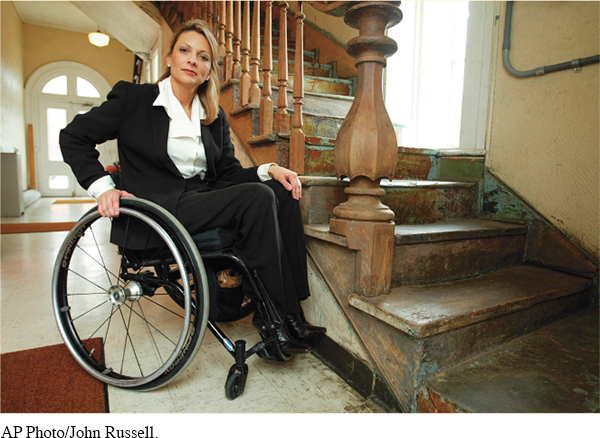The American Promise: Printed Page 894
EXPERIENCING THE AMERICAN PROMISE
The American Promise: Printed Page 894
Page 894Suing for Access: Disability and the Courts
When the ADA passed in 1990, Beverly Jones expressed her elation: “For me, the passage of the ADA was like opening a door that had been closed to me for so long.” The measure banned discrimination against people with disabilities by private employers, public agencies, and state and local governments. This civil rights act providing equal access and opportunity followed in a long tradition of Americans fighting for their rights, struggling not only to enact laws but also to see them enforced.
Jones, a single mother with two children, joined the ranks of the 2.2 million wheelchair-
Jones pleaded in vain with local, state, and federal officials to obtain compliance with the law. “The door that I thought had been opened was still closed and my freedom to live my dream was turning into a nightmare,” she said. Finally, in 1998, after having to ask a judge to carry her to a restroom, she decided to appeal to the courts.
Jones filed a lawsuit against the state of Tennessee, joining five other plaintiffs who alleged that the state was in violation of Title II of the ADA, which prohibits governmental entities from denying public services, programs, and activities to individuals with a disability. A co-
Tennessee immediately countersued, challenging the constitutionality of the ADA’s requirement that states make public facilities accessible to people with disabilities and arguing that the Eleventh Amendment to the Constitution granted states sovereign immunity (protection from lawsuits). Carol Westlake, executive director of the Tennessee Disability Coalition, pointed out that Tennessee’s claim of states’ rights was the same argument used to deny civil rights to African Americans in the 1950s and 1960s. After six years of litigation, the case of Tennessee v. Lane reached the Supreme Court in 2004. As the justices heard arguments, activists demonstrated outside the Court, chanting, “Justice for all: we won’t crawl.”
At stake was not only the right of people with disabilities to sue a state when denied access to public facilities, but also the right of Congress to make federal laws binding on the states. In May 2004, the Supreme Court ruled in a five-
Jones recognized that she was part of a larger struggle. “This Supreme Court ruling wasn’t about Beverly Jones; it means equal access to the justice system for 54 million Americans with disabilities.” While she rejoiced in having “accomplished what we wanted to be achieved,” she was also sobered by the narrow grounds on which the Court decided her case. A year after Tennessee v. Lane, Jones testified before the Senate Judiciary Committee on the nomination of John Roberts to the position of chief justice of the United States. Pointing to the fragility of her victory, she urged the senators to “pay close attention to whether John Roberts has proven that he would ensure that the rights [that] people with disabilities fought so hard to secure are not stripped away.”

Questions for Analysis
Recognize Viewpoints: On what basis did Tennessee oppose Jones’s lawsuit? What argument did the state present, and how did it support that argument?
Ask Historical Questions: In what ways was the struggle for disability rights similar to and different from other minority rights movements? Provide another historical example of how an individual’s struggle on her or his own behalf affected a much larger population.
Consider the Context: Why was disability rights legislation one of the few pieces of reform legislation that passed in the 1990s?